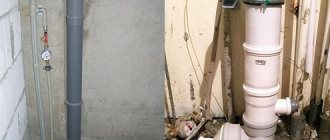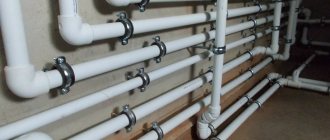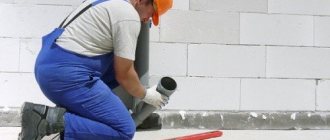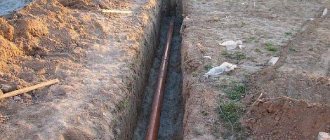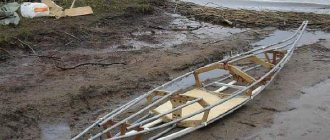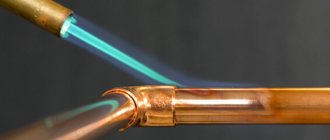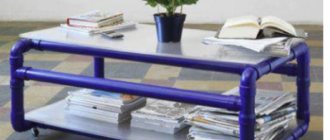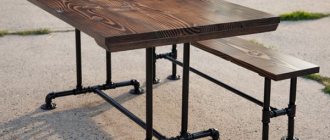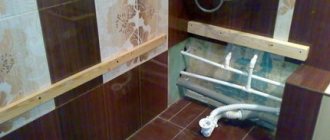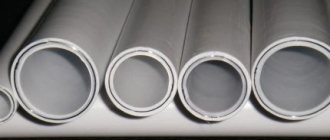Drainage systems and other pipeline networks in apartments of apartment buildings are often equipped with cast iron pipes. Despite the emergence of pipe products made from new, modern materials, cast iron products are still preferred by many apartment owners and specialists involved in servicing pipeline systems. In the article we will talk about a frequently used method of connecting cast iron pipeline parts - embossing and stamping. We will describe the method, suggest the best materials, and give useful tips.
The use of cast iron pipes in pipelines of apartment buildings
Recently, plastic has been widely used, but cast iron has been and remains the main material for constructing sewer networks. Its main advantage is durability. It should not be forgotten that the strength characteristics of cast iron are associated with fragility. These features must be taken into account when minting cast iron pressure pipes. In addition to the above, cast iron products are superior to plastic in the following qualities:
- rigidity;
- wear resistance;
- ability to withstand temperature changes;
- fire resistance;
- low noise level.
Cast iron pipes GOST 9583-75 are used not only in the sewerage system. They are used: in the manufacture of water supply networks, in heat supply pipelines for residential buildings, in fire extinguishing systems. Many residents are in no hurry to abandon heat-intensive cast iron radiators.
How to caulk a cast iron water pipe?
Cast iron pipes, as a rule, are strongly associated with sewerage. Few people know that they have been widely used for laying water supply lines for more than two centuries. In this material we will study the features of cast iron water pipelines, GOST requirements for them, and the methods of installation and repair used.
A section of a cast iron water supply main.
Standard
The current standard for gray cast iron water pipes was introduced in 1977; the latest changes were made to the text quite recently, in 2011. So, what should cast iron pipes for water supply be like according to GOST 9583-95?
Methods for connecting cast iron pipeline parts
Assembling and installing a new section of cast iron pipe is a complex task. There are two connection methods.
- Clutch. This method is more suitable for socketless pipes: a special coupling wraps around the edges of the parts to be connected. There are couplings without threaded clamps, consisting of two sockets. The ends of the parts to be connected are inserted into them. The method is not complicated, and the reliability and build quality are high.
- In the bell. This is the most common type, which is also called “chasing cast iron pipes.” A correctly performed caulking process allows the pipeline to operate without leaks for several decades.
The embossing of sewer pipes made of cast iron, connected “in a socket”, is carried out using different materials. The most famous are cement or asbestos-cement mixture. The most accessible method of coining is cement bonding. Cement does not allow water to pass through and is capable of expanding and compacting when hardened.
What materials are used to make it?
Pipe caulking in a sewerage system can be done using:
- heels;
- fill with gray.
And, if filling with sulfur is considered the old Soviet method, then chasing pipes with a heel can be done with your own hands with minimal theoretical training and a set of tools.
A heel is a rope made of flax, hemp or jute impregnated with an antiseptic and resinous substances. It is used for sealing joints and seams of sockets and, thanks to impregnation, provides high resistance to rotting and biostability. The consumption of the strand for embossing pipes is calculated based on their dimensions: the length of the strand must exceed the circumference of the pipe by 25%, and its thickness must be such that it fits tightly into the annular gap. In this case, the heel should be placed in the socket in three bundles so that the overlaps of its ends are in different places along the circumference of the pipe. In the construction of sewer systems, tarred strands are sometimes replaced with rubber rings.
The joint over the heel is sealed with various filler materials. They ensure complete tightness of the connection and prevent the heel from being pushed out under the pressure of the system contents. The following is used as a placeholder:
- cement;
- asbestos cement;
- lead.
The disadvantage of cement-based aggregates is their relative rigidity. If a leak forms in a joint, it is impossible to repair it without preliminary caulking, with minimal time and labor costs. Although, to seal the joints of the sockets of cast iron pipes, asbestos cement is still used: compared to cement, it has higher elasticity.
If sealing the seams of sockets using cement and asbestos cement is not difficult, then chasing cast iron pipes with lead is a more complex procedure and requires skills. After caulking the gap with a strand of resin, a rope is placed in the socket gap, which is covered with a layer of clay on top. Using the free ends, after the binder has almost completely dried, the rope is pulled out of the socket slot, and straightened lead is poured into the sprue formed in its place. So that the vapors formed in the bell slot during the process of filling it with lead can freely escape, a hole is pierced in the side of the sprue.
Technology for minting cast iron pipes
The technology is as follows: the bell gap is filled with a sealant and sealing is ensured using special hardening compounds. The sealant is usually a tarred strand of hemp, the so-called hemp, with which the socket is stuffed ⅔ full, with careful compaction. After the heel is tightly placed in the holes of the pipe and socket, the end of the rope is overlapped over the ring so that it does not get inside.
The next step is to prepare cement. It is diluted with water 9:1, and after cooling it is poured into the joint. Use a hammer to hammer the cement mixture into the joint so that the solution adheres to the tarred rope. Cover the cemented area with a damp cloth to allow it to harden slowly without cracking.
Preparation for the process of caulking cast iron pipes with asbestos is somewhat different. To prepare the solution, a dry mixture of asbestos fibers is mixed with cement in a 1:2 ratio. The resulting mass is diluted with water so that it increases by 10-12%. The remaining steps are identical - pouring, filling the cracks with a tool and waiting for the hardening period.
Methods for caulking pipes and options for its neutralization
Embossing a pipe, that is, connecting its elements, can be done in three ways. Moreover, each of them requires its own specific approach.
Nowadays, in order to connect elements, it is not at all necessary to caulk the pipe. This can be done using a special adapter coupling. Moreover, such an element can connect pipes made of various materials, for example, cast iron and plastic.
Pipe embossing can be made from different materials. Various pipe caulking and ways to eliminate it:
- It will be easiest to separate the elements if they were caulked. This is a rope that is wound around pipes and compacted. To check whether this method was used, you need to hit the socket several times with a rubber hammer, and then try to loosen it. If the pipe gives in, then most likely it was the heel that was used. In this case, you need to pick out the top layer of the rope with a screwdriver, find its end and pull it out. Throughout the entire work, it is necessary to carefully loosen the pipe. They shake it until they can pull out the required element. If the top of the heel was covered with cement mortar, then it must first be knocked down. To do this, place a screwdriver on it at an angle and tap it.
- In Soviet times, the heel was used infrequently. Sulfur was much more common. In this case, you will have to do quite dangerous work. You will definitely need to wear a gas mask, because sulfur vapors will be released, which are extremely poisonous. It is also necessary to ventilate the apartment. So, you need to melt the sulfur with a blowtorch so that it becomes liquid. When heating, it is necessary to periodically tap the pipe until noticeable movement appears. When the pipe itself heats up, you will need to take it with an adjustable wrench and pull it towards you with force. This will free up the required element.
This is how pipes are caulked. It is worth noting that the option with sulfur is the most dangerous. Therefore, if you do not have a gas mask or a special construction respirator, then it is better not to start at all.
Tools and materials
The following tools are used for stamping cast iron sewer pipes:
- caulks of different sizes;
- hammers (simple, rubber);
- screwdriver;
- hacksaw or electric saw for cutting metal workpieces.
It is important to correctly connect and seal the cast iron elements. As a sealing material, in addition to hemp, flax strands twisted into a rope and high-quality tow made from hemp fibers are used. It is important to ensure that the tow is free of wood impurities. The presence of wood in tow will worsen the insulating functions - leaks will begin. The thickness of the sealant strands should be greater than the width of the socket gap.
Asbestos-cement mixture and cement mortar improve the quality of caulking of sewer pipe sockets and connections of cast iron pipes for other purposes. Cementing extends their service life without accidents.
A frequently used method for connecting pipes in pressure systems is lead hammering. Lead is a metal with a low melting point. The melt fills the socket with the seal well and secures it securely.
Filling is also carried out with sulfur. If all conditions are met, a strong connection is obtained. You cannot overheat sulfur, it becomes brittle. In addition, you should know that to reduce the risk of cracks appearing at the embossing site, 10-15% kaolin is added to the molten sulfur.
Pipe caulking technology
Difficulty may also arise when caulking cast iron or plastic pipes, which occurs when replacing a riser or toilet unit. For correct actions, you need to very carefully mint the pipeline pipe. This action includes several stages:
- The first thing we need to do is to tap the bell with a hammer, so as not to damage it;
- If the bell moves smoothly and can be easily dismantled, this means that the caulking was done with a heel.
- Next, you can begin dismantling - loosen the bell, pry it off with a screwdriver and pull the cord out a little. Then use pliers to carefully pull out the rope.
If the bell does not move when tapped, this means that the embossing was done with sulfur. In this situation, you need to use burning technology:
- Carefully heat the pipeline around the circumference with a torch or blowtorch;
- To avoid damage, carefully tap the pipeline with a hammer;
- When the bell is movable, you can loosen it with an adjustable tool.
Attention! When performing work, you must use a respirator to avoid inhaling sulfur.
- After freeing the bell, clean it with a chisel;
- We cover the sealing ring with a special solution and insert it into the socket;
- We install a new part into the seal.
Step-by-step caulking of a cast iron socket
The first step is to turn off the water in the apartment. Repairs must begin with a visual inspection of the system. Upon inspection, it is determined how they are connected. When caulking a section of a pipeline that is planned to continue to be used, you should work carefully, without damaging the pipe body and socket. The work plan is as follows:
- Use a grinder to cut off the part of the riser that is located below the connection;
- separate the bell and the cut fragment;
- heat the joint if the piece is difficult to pull out.
Before caulking cast iron water pipes, it is necessary to determine what material the seal is made of. To do this, remove the waterproofing solution.
How to hammer a bell
During repair work, reconstruction or expansion of the drainage system, it often becomes necessary to connect different lines. Before caulking a sewer pipe, it is often necessary to disassemble an old, defective connection. It is extremely difficult to hammer out a bell that has become overgrown with monolithic layers over many years. The main problem is the danger of destroying the socket of an entire pipe or tee. If this happens, you will have to disassemble and replace the entire riser or horizontal pipeline.
Before caulking out an old cast-iron sewer, it is necessary to clean the connecting element and remove all foreign objects and deposits. As a rule, various temporary patches of paint, additional layers of mortar, and other materials are applied over the standard connection. All such areas must be completely removed.
After this, it is necessary to determine what material the insulating seal is made of, since it is much easier to caulk a cast iron sewer with cement than with sulfur. If cement mortar is used, the process of disassembling the joint will be easier. However, if pouring with plumbing sulfur was used, the procedure will be complicated. The material will have to be heated with a gas torch or blowtorch, since it will not be possible to simply break and remove particles from the gap - sulfur has high strength and viscosity. You will have to work in a gas mask, since toxic gases will be released when heated.
Procedure
In order to caulk a cast iron drain, you must first remove the cement or sulfur filling (1/3 of the depth of the socket), and then remove the hemp strand (2/3 of the depth). The first stage requires caution and accuracy. There is a high risk of breaking the socket of a tee or other receiving element. First they use a chisel, then a screwdriver with a long thin blade. With gentle blows of a hammer, the screwdriver is immersed in the gap, breaking off small pieces of the seal.
Many sources recommend first tapping the socket around the circumference with a hammer, and then checking to see if the pipeline has become loose. This is useless advice, since it is impossible to caulk cast iron sewers in this way. Until the top layer of cement or sulfur is removed, the pipe will not be able to swing. In addition, hammer blows can break the socket, which will significantly increase the amount of work.
When the hard plug is removed, the joint will gain mobility. They move it a little to the side, pick up the rope and pull it out, swinging the pipe to the sides to facilitate the process. After this, the bell will be completely freed, the connecting element can be easily removed.
Also read: What is the danger of sewer smell to health: the composition of the gas, where it comes from
Caulking of pipe joints with various types of joints
If sulfur was used when installing the pipe, the joint is heated with a blowtorch until the sealant completely melts. When the connection cools, the pipe will easily unscrew. If the pipe swings and turns at the junction, it means that a heel was used. Before removing it, carefully swing the pipe, use a screwdriver to pick up a strand, and remove it. This process is much simpler than caulking pipes installed on sulfur.
Profession of a worker performing coining and coining operations
Embossing and chasing has many nuances. This is done by a qualified plumber. When you call a pipeline specialist, you have more confidence that the appropriate materials will be used, technological details will be observed, and the solidification time of the solution or melt will be maintained.
What skills do you need to have to perform minting?
According to the Unified Tariff and Qualification Reference Book (UTKS), a 2nd category plumber must be able to prepare sealing strands and cement mortars. Plumbers of the 3rd category and above must be able to make pipe connections. Of course, they must have skills in working with tools, both measuring and plumbing, understand the details of pipelines and know safe working practices.
Video review:
Everything useful about sewerage -
Do-it-yourself installation of sewer pipes requires the contractor to fully comply with construction rules and regulations. In most cases, these issues have already been resolved for multi-apartment buildings, so this process is relevant for private houses and summer cottages. It is for this reason that owners need to know all the nuances of constructing a drainage system. In our article we will find out how to make a sewer with your own hands.
Installation of water pipes requires drawing up communication plans. All components of the structure must be indicated and marked in the photo: dimensions of elements, location of fittings, system lines. In practice, most plumbing fixtures are connected to one riser, but if the room is large, it is better to connect to several points.
When the question arises about installing a sewer system, you can start from the photo of the previous wiring diagram in the building. It is worth considering that if a cast iron pipe is replaced with a plastic one, then it is impossible to rely on the old system.
Attention! With a large number of floors in a building, it is rational to place plumbing units one below the other.
When performing repair work, it is enough to make a schematic drawing of the divorce system. But, if sewerage is being installed, it is impossible to do without drawing up a project. This standard is necessary due to the existence of an internal and external design of the drainage system. Plus, most cases also involve the installation of a cleaning device.
Safety rules for installation and repair of cast iron pipes
When working with cast iron, to avoid injury, you need to wear special clothing, gloves or mittens. It is prohibited to use an iron hammer. If you don't have a rubber tool, use a wooden one. A respirator and safety glasses will help protect your respiratory tract and eyes from metal fragments. The workplace of a plumber must meet the requirements of fire safety regulations. Caution should also be exercised at home.
When working with the pipeline in a multi-family apartment, it is worth remembering that unskilled actions can lead to leaks and sewage entering the lower floors. To avoid troubles, it is worth minting under the guidance or with the participation of a specialist. If you have no skills at all, it is better to contact an experienced plumber. In this case, the pipe will last a long time after minting.
Cutting off an unnecessary section of pipe
If you want to repair or replace a sewer or water pipe system, you need to carry out each step step by step. After all, this process is different in that if it fails, you can damage your neighbors’ sewer system.
Chasing a toilet outlet is difficult because in order to dismantle this element of plumbing, it will have to be broken. It will not be possible to remove it whole.
Before you begin caulking the sewer system, it is necessary to repair the damaged area. There are several recommendations for this case.
The first stage of caulking cast iron sewer:
- The end pipe is very easy to replace. Here you won’t have to do any special work other than the caulking itself.
- If you want to replace the central part of the sewer riser, then this will be more difficult. Here you will have to make a cut.
- Four centimeters from the common pipe, make a cut in a circle. Use a protective mask, goggles and gloves.
- The unfinished part is carefully finished with a hacksaw. It is not recommended to hit the pipe with a hammer. The fact is that the fragility of metal is unpredictable; upon impact, instead of a damaged pipe, the required part may burst, and in this case, the next element will have to be replaced.
- We tie a large piece of rags to the pipe, then stick it into it. This is necessary to prevent foreign objects from getting into the riser.
- Now they go down some distance from the cut along the damaged element so that there are 20-30 centimeters left to the point of caulking, and we make a new cut. Carefully remove the cut piece.
- The hole in the pipe is again covered with a rag.
When cutting a pipe, all actions must be performed very carefully. Do not cut the product flush, as this increases the danger of work.
It is very convenient to do such work together with a friend. Then one person can hold the element to be cut, and the other can cut.
Installation of plastic sewer pipes
Installation of plastic sewer pipes is slightly different from other types. For this reason, we provide some tips on how to mint them:
- There are two ways to cut plastic pipe. It is worth noting that the saw for such work must have small teeth. This task can also be performed using a two-handed cable.
- You should not leave burrs, which very often appear when cutting plastic products.
- We carry out cleaning and gluing of materials. First, you need to perform dry assembly, and then you can begin gluing the system. To do this, we apply marks and then connect the structural elements with glue.
- We assemble a sewerage pipeline system.
- We fill in all the empty spaces.
- We install a plastic pipe for ventilation. The connection must be made with copper material.
- Plastic pipes are used for highly complex connections. The strength of the tightness of the structure is ensured by couplings without a socket.
- We strengthen the risers. To do this, you should use metal pads - this element will protect against accidental contact with small parts, such as nails or screws.
So, we found out that installing a sewer system is quite simple. The article presents two options for completing the process - a design with cast iron and plastic pipes. The main requirement for installation is compliance with the norms and rules that are regulated by SNiP and GOST of the Russian Federation. So, study the legislative framework and construction and sanitary conditions, and then you will be able to install a drainage system in your own house or apartment correctly.
A modern sewer system is a complex structure that greatly increases the comfort of life for the inhabitants of a country house or apartment in a multi-storey building. In order for the sewer system to function efficiently, during the installation work it is necessary to ensure that everything is done correctly, otherwise you may encounter troubles during operation.
Over time, sewer pipes fail and require replacement. Considering that in most Soviet-era buildings predominantly cast iron pipes were used for the installation of the sewer system, now it is necessary to carry out either a complete or partial replacement.
Chasing and caulking of sewer pipes
Note!
Cast iron pipes, when exposed to aggressive external factors, can lose their functionality and fail in exactly the same way as plastic products and steel pipes.
An important place in the process of repairing sewer pipes made of cast iron is their caulking and caulking - procedures that are carried out using special technologies and building materials.
Anyone who assumes that dismantling a sewer pipe is easier than installing it is mistaken. The first stage on the path to replacing an unsuitable element is caulking of sewer pipes, or rather caulking. To complete this work you need to put in a lot of effort and effort. This work is quite dirty and unpleasant.
Chasing a sewer pipe is required if the socket method was used during installation work.
Note!
Chasing is performed in different ways depending on what method was used to give strength and reliability to the connection.
To figure out how to caulk a sewer pipe, you need to determine whether a sealant or sealant will be used to connect the cast iron pipes to each other.
- Tapping the pipe onto the seal begins with the tedious process of beating off the waterproofing layer using a special rubberized hammer. After this, the joint is loosened, the casing is removed, and the sewer pipe is removed from the socket.
- Caulking the pipe on the sealant is done a little differently. First you need to tap the joint, then remove the waterproofing layer, burn the sealant with a blowtorch. Once the pipe has cooled, it can be removed from the socket without effort.
Note!
After caulking has been done and the damaged part of the cast iron sewer pipe has been removed, it is not recommended to install a replacement made from the wrong material. It is better to replace the cast iron pipe with a plastic analogue. Plastic does not sacrifice anything to cast iron, but is a lighter and cheaper material, and it is not subject to corrosion.


